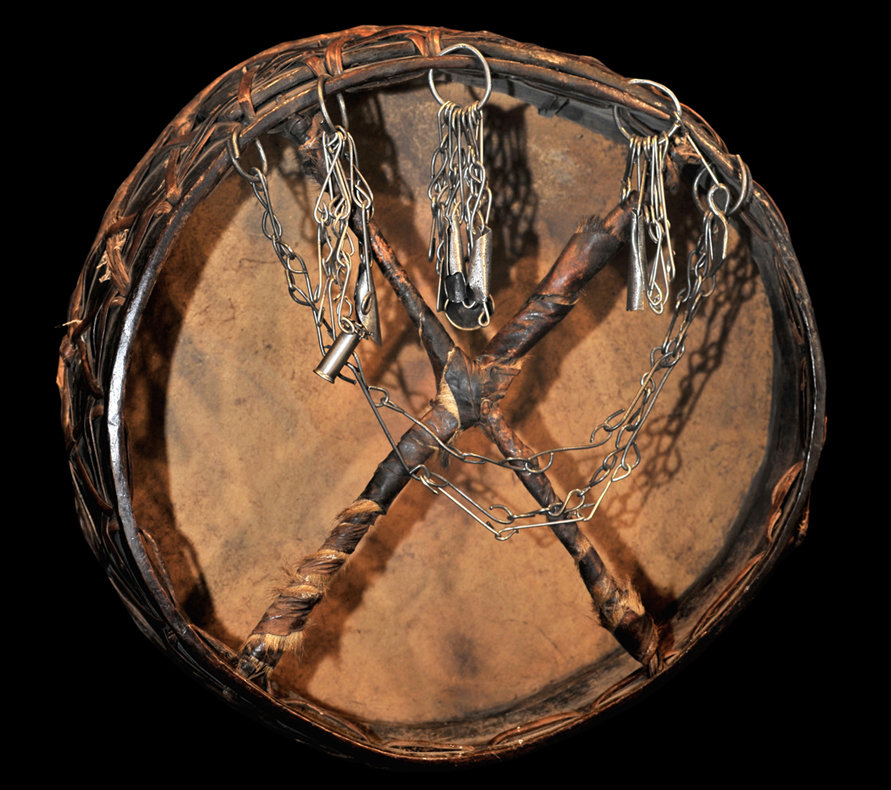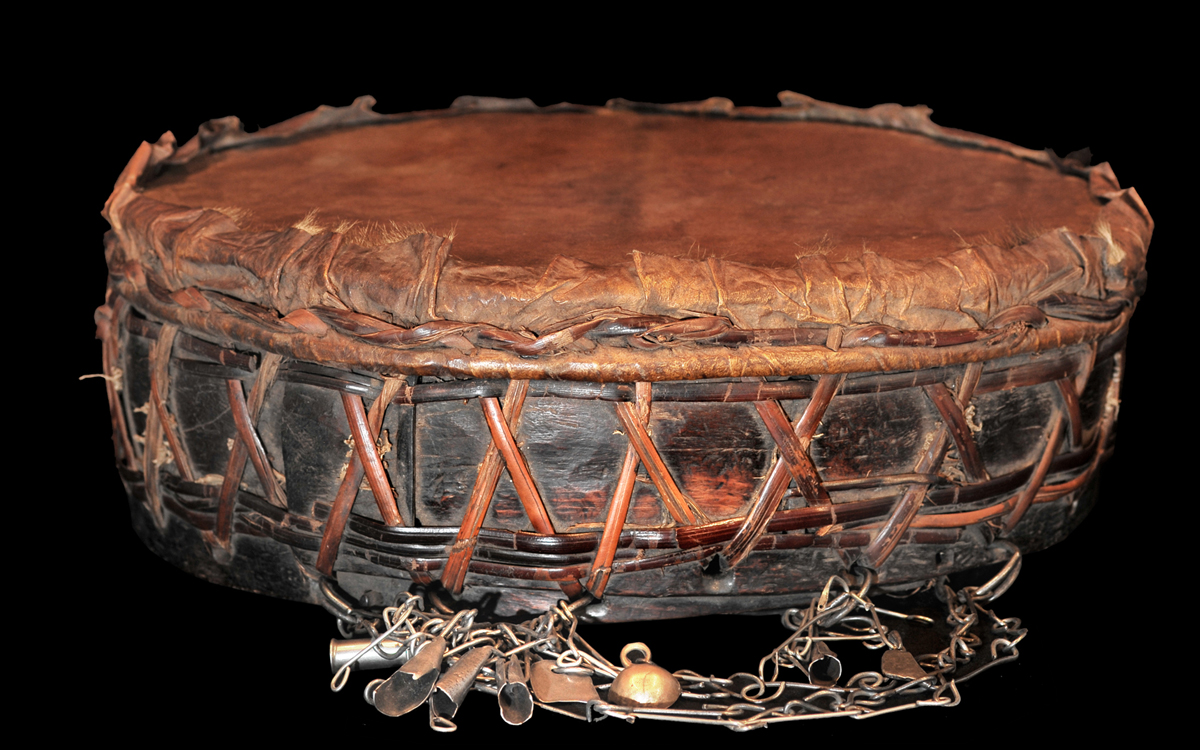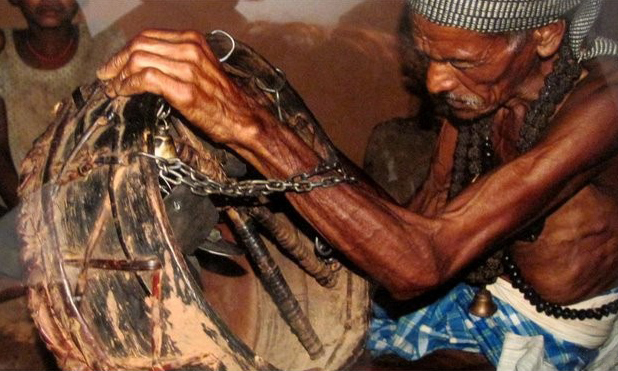DRUMS OF THE WORLD
Himalaya
Chepang shaman drum Nepal
Chepang shaman drum / Schamanentrommel Nepal
The drums are the medium through which the shaman (pande) makes communication with the supernatural forces. Therefore they are considered as sacred. Various iron hangings around the drum hold great power as they are supposed to protect from some possible attacks form spirits and malefic beings.
The chepang drum "(...)generally varies in diameter which can be anything from forty to fifty centimeters, and the frame, which is about twenty centimeters wide, is made of wood from a tree called sandan in Nepali and bunsi in Chepang. The membrane is made of goat’s hide.(...)The ring grip is fixed, internal and cross shaped. It is usually made of the same wood as the frame and then covered with a strip of the same goat’s hide as that used for the membrane, though one can occasionally find iron grips in the shape of a cross. There are a varying number of iron chains with different symbolic hangings fixed to the upper part of the frame by means of iron rings. These are located on the inside of the drum opposite the membrane and usually face the pande during seances. Chepang drum skins are never painted by the pande(...)" excerpt from: Riboli, Diana (2000) TUNSURIBAN - Shamanism in the Chepang of Southern and Central Nepal.
"The shaman’s drum is not just a rhythm instrument with which faith healers add an acoustic component to their rituals. It is a self-contained embodiment of the cosmos in which their owners travel in the course of their séances. (...) The drum’s numerous functions—as a musical instrument accompanying the recitation of mythical songs, as a pacemaker of ritual dances, as a vehicle on which the shaman travels through space, as a defensive and assault weapon against negative powers, as a diagnostic and prognostic instrument - make it a kind of all- purpose companion to its owner." excerpt from: MICHAEL OPPITZ : Forschungen an den Rändern der Schrift 26 January – 14 April 2018 exhibition at Galerie Buchholz - Edit Daniel Buchholz
Bibliography:
Oppitz, Michael (2013) : Morphologie der Schamanentrommel.
Oppitz, Michael (2013) : Schamanen im Blinden Land (5 DVDs + 2 CDs)
Pannier, F. (2007) : Art chamanique népalais - Nepalese shamanic art. Galerie leToit du Monde.
Nioradze, G.(1925 ) : Der Schamanismus bei den Sibirischen Volkern. Strecker und Schröder.
Eliade, Mircea (1964) : Shamanism - Archaic Techniques of Ecstasy.
Diószegi, Vilmos ; Hoppál, Mihály (1978) : Shamanism in Siberia. Akadémiai Kiadó, Budapest.
Hoppál, Mihály (1994) : Schamanen und Schamanismus. Pattloch, Augsburg.
Diószegi, Vilmos (1963): Glaubenswelt und Folklore der sibirischen Völker.
Manker, Ernst (1938) : Die Lappische Zaubertrommel - Die Trommel als Denkmal materieller Kultur. Acta Lapponica, I
Manker, Ernst (1950) : Die Lappische Zaubertrommel - Die Trommel als Urkunde geistigen Lebens. Acta Lapponica, VI
Hitchcock, John; Jones, R. (Editor) (1976) : Spirit Possession in the Nepal Himalayas.
Mastromattei, R. ; Farano, F. (2006) : Rta. Sciamani in Eurasia. Il rito che sopravvive.
Riboli, Diana (2000) : Tunsuriban. Shamanism in the Chepang of Central and Southern Nepal
Sales, Anna de (1991) : Je suis né de vos jeux de tambours. La religion chamanique des Magar du Nord.
The drums are the medium through which the shaman (pande) makes communication with the supernatural forces. Therefore they are considered as sacred. Various iron hangings around the drum hold great power as they are supposed to protect from some possible attacks form spirits and malefic beings.
The chepang drum "(...)generally varies in diameter which can be anything from forty to fifty centimeters, and the frame, which is about twenty centimeters wide, is made of wood from a tree called sandan in Nepali and bunsi in Chepang. The membrane is made of goat’s hide.(...)The ring grip is fixed, internal and cross shaped. It is usually made of the same wood as the frame and then covered with a strip of the same goat’s hide as that used for the membrane, though one can occasionally find iron grips in the shape of a cross. There are a varying number of iron chains with different symbolic hangings fixed to the upper part of the frame by means of iron rings. These are located on the inside of the drum opposite the membrane and usually face the pande during seances. Chepang drum skins are never painted by the pande(...)" excerpt from: Riboli, Diana (2000) TUNSURIBAN - Shamanism in the Chepang of Southern and Central Nepal.
"The shaman’s drum is not just a rhythm instrument with which faith healers add an acoustic component to their rituals. It is a self-contained embodiment of the cosmos in which their owners travel in the course of their séances. (...) The drum’s numerous functions—as a musical instrument accompanying the recitation of mythical songs, as a pacemaker of ritual dances, as a vehicle on which the shaman travels through space, as a defensive and assault weapon against negative powers, as a diagnostic and prognostic instrument - make it a kind of all- purpose companion to its owner." excerpt from: MICHAEL OPPITZ : Forschungen an den Rändern der Schrift 26 January – 14 April 2018 exhibition at Galerie Buchholz - Edit Daniel Buchholz
Bibliography:
Oppitz, Michael (2013) : Morphologie der Schamanentrommel.
Oppitz, Michael (2013) : Schamanen im Blinden Land (5 DVDs + 2 CDs)
Pannier, F. (2007) : Art chamanique népalais - Nepalese shamanic art. Galerie leToit du Monde.
Nioradze, G.(1925 ) : Der Schamanismus bei den Sibirischen Volkern. Strecker und Schröder.
Eliade, Mircea (1964) : Shamanism - Archaic Techniques of Ecstasy.
Diószegi, Vilmos ; Hoppál, Mihály (1978) : Shamanism in Siberia. Akadémiai Kiadó, Budapest.
Hoppál, Mihály (1994) : Schamanen und Schamanismus. Pattloch, Augsburg.
Diószegi, Vilmos (1963): Glaubenswelt und Folklore der sibirischen Völker.
Manker, Ernst (1938) : Die Lappische Zaubertrommel - Die Trommel als Denkmal materieller Kultur. Acta Lapponica, I
Manker, Ernst (1950) : Die Lappische Zaubertrommel - Die Trommel als Urkunde geistigen Lebens. Acta Lapponica, VI
Hitchcock, John; Jones, R. (Editor) (1976) : Spirit Possession in the Nepal Himalayas.
Mastromattei, R. ; Farano, F. (2006) : Rta. Sciamani in Eurasia. Il rito che sopravvive.
Riboli, Diana (2000) : Tunsuriban. Shamanism in the Chepang of Central and Southern Nepal
Sales, Anna de (1991) : Je suis né de vos jeux de tambours. La religion chamanique des Magar du Nord.


